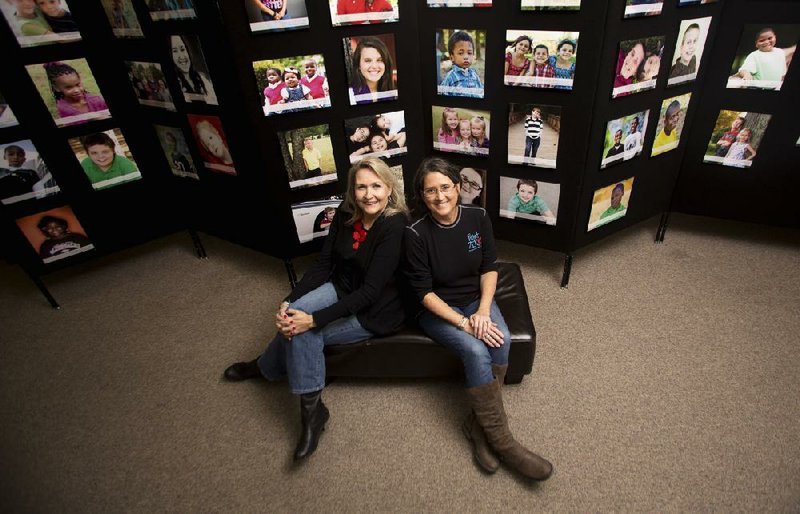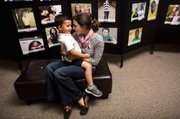Project Zero’s new way to encourage adoption is an exhibition of 125 children’s portraits, each the photo of a child in need of a family.
Unveiled at the group’s Heart Gallery Gala earlier in November - National Adoption Month - the show is a traveling version of the online Arkansas Heart Gallery.
“You can ignore statistics,” Project Zero founder and co-director Christie Erwin says, “but you can’t ignore faces.”
About 500 children in Arkansas - 130,000 nationally - live in foster homes under state care, according to government statistics.
Orphaned, abandoned, mistreated, given up, they have had rough beginnings. Some go from one foster placement to another, never settled.
“There’s an innate value to these kids,” Erwin says. Hoping for adoption, they want no more, in her view, than the homes they deserve.
Unwanted, they grow up lackingthe security of what she and Project Zero co-director Caryl Watson call “forever families.”
Faces tell how it feels to believe someone is coming to make things better, and sometimes how it feels to lose hope.
Project Zero’s goal is to connect children in need of families with adoptive parents - to help them find each other. Erwin, Watson and a crew of volunteers collaborate with the state’s public adoption agency, the Department of Human Services, Division of Children and Families.
“It’s a calling,” Watson says.
Erwin counts a growing number of success stories: 30 adoptions this year “as a result of events we have hosted or connections we have made.” One way to connect is, “someone sees a child in the Heart Gallery.”
Project Zero’s online Heart Gallery is at the organization’s website, theprojectzero.org. The state’s Arkansas Heart Gallery adds biographies to some of the same photos at adoptarkansas.org. Also, the state site includes information on how to adopt. The Heart Gallery of America is another place to find children from Arkansas, at heartgalleryofamerica.org.
The traveling exhibit expands the idea from pictures on the computer to 11-by-14-inch photo prints on 18 folding panels - “a huge project,” Erwin says.
By posting on Facebook that she needed help to take children’s pictures for the project, she enlisted the work of 30 volunteer photographers across the state.
Erwin expects the exhibit will travel statewide, with locations to be announced on Project Zero’s website. It has already appeared at several sites, including The Summit Church in North Little Rock.
Of the children pictured, she reports, “several of them already have been matched with forever families.”
But Watson is troubled by the traveling exhibit’s picture of an 11-year-old girl named Tamiyah: the eyes narrowed, the mouth bent low. The photographer tried to coax a smile, Watson says. Tamiyah didn’t have one.
LONG WAIT
Watson carries a photo of how Tamiyah looked four years ago: the snap of light in the girl’s dark eyes, the playful expression.
The photo gallery shows a number of children as happy-looking as Tamiyah was before the wait for adoption caused her to lose faith in the system, Watson says.
Their smiles make her wonder what changes will come to them in years of disappointment. The question helps keep her working to convince people to open their homes.
“You find the energy you need,” she says.
“Both of us have a driving passion to find families,” Erwin says.
Longtime friends, the two women share a common experience. Both have been foster mothers, and both have adopted children - two each. They share in Project Zero as well.
Erwin describes the 2-year-old organization as a “ramped up” version of its predecessor, the Pulaski County Adoption Coalition, of which she was chairman.
As proponents and facilitators of adoption - but not an adoption agency - “we have no say in where children are placed,” Erwin says. She cites three ways they have to help: Raise hope, enlist mentors, and call attention by such means as the Heart Gallery.
The traveling show’s faces include that of blue-eyed, 16-year-old David Graybill.
GOOD EXAMPLE
David has been in foster care most of his life. The circumstance gave him a “negative attitude,” he says, “but I was only hurting myself.”
He looks to the good - that he has friends in the group home where he lives near Bryant, and that Erwin and Watson are doing all they can to help him find an adoptive home.
He lends his face to the Arkansas Heart Gallery and to a video for Project Zero “because there’s a stereotype in foster care that it’s all bad kids. They’re only made to fill up [jail] cells. That’s what they’re for.”
By holding his school grades to As and Bs with an eye toward medical school, David says, he hopes to show a different side to the plight of being without a family.
David wears two bracelets:one a red token of support for the Arkansas Razorbacks football team no matter how often they lose. His own wish to play school football is broken by a lack of transportation, he says: There’s nobody to drive him to and from practice.
The other bracelet is from Project Zero with the slogan, “1 + 1 = 0.” It means, “One child plus one family equals zero kids waiting.”
Project Zero volunteer Shannon Newton and her husband have cleared the state’s process to become adoptive parents. They have prayed about it, she says, and know they will be adding in this way to their biological family: a 6-year-old son and a 4-year-old daughter.
“I Googled adoption,” she says, “and the Heart Gallery is what came up.”
On “pre-adoption watch,” they have expressed an interest in several children without knowing which might come their way.
“We have an extra room and a bed in it,” she says. “We’re waiting.”
The wait is over for adoptive mother Megan Garrison, who credits Project Zero with having “got us going” - she and her husband - through the adoption process.
While looking for an infant, they found siblings Lucy, 6 and Shep, 5, “the best thing that ever happened to us.”
The children arrived with “basically nothing,” she says.” They had what they were wearing. I don’t have any pictures of them before they came to live with us.”
Adoptive parents might know a lot about what happened to cast a child into the care of strangers. But they don’t know the countless little things that make a personality.
Frequently, Watson says, the starting point is a child’s birthday to celebrate together, the making of a new memory in place of so many missing ones.
Children come to adoption out of hardship. The rules sometimes stipulate what kind of family they need in order to feel safe, or say they have to continue counseling.
They come with challenges, Watson says, “but we all come with challenges.”ON THE ROAD
Project Zero grew from efforts to match adoptive families and children in Pulaski County, Erwin says. The Heart Galley started with pictures of children from the county in 2007, and led to an earlier version of the traveling exhibit.
“In one 18-month period,” she recalls, she and Watson moved the show 73 times in their SUVs, “all the while fostering and adopting children ourselves.”
The new traveling Arkansas Heart Gallery is bigger still, “from all over Arkansas,” she says, and one more way to find families willing to open their homes. But even with this new project on the go, she is looking for others.
“We become more and more aware every day that kids in foster care have been let down,” she says. “There is just not enough urgency in finding the right forever family for each of them.”
Compelling as they are, these pictures might not be enough.
“We have to move you,” Erwin says, ”and then move you to the next step - stepping up to say, ‘I’m willing.’”
Family, Pages 35 on 11/27/2013


